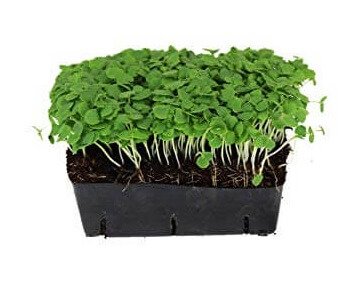Have you ever consider basil microgreens instead of full-sized basil? If you haven’t it’s time you did! Fortunately, this guide will show you how to grow basil microgreens; it’s easy and surprisingly beneficial to your health.
Research shows that basil microgreens contain as much as 4-5 times the nutrients that mature basil does! Of course, to retain those nutrients you’ll want to eat this raw.
It is worth noting that basil microgreens are one of the slowest growing microgreen options you can choose. Of course, they will still be ready in a matter of weeks.
As with any of the microgreens, you need very little equipment, a growing tray, growing media, water, and the seeds should suffice!

Basil Microgreens Health Benefits
Basil microgreens are surprisingly full of nutrients. They contain protein, vitamins E, A, K, B6, and C; as well as calcium, iron, zinc, magnesium, copper, phosphorous, and even potassium!
That adds up to a lot of benefits:
- Anti-Inflammatory & anti-bacterial
There are a number of chemicals in basil microgreens, including citronellol and linalool, which are known to reduce inflammation in the body and even tackle bacterial infections.
This makes it a great addition to your diet, especially if you’re already suffering for aches and pains.
- Bone Strength
The calcium in basil microgreens ensures that your bones and teeth will stay strong. In fact, the array of nutrients can even help to keep osteoporosis at bay.
- Hormone Regulation
Your body needs protein, zinc, magnesium and several of the other nutrients in these plants. Adequate quantities of these will help to ensure your hormones remain balanced; helping you to stay healthy.
- Blood Clotting & Formation
The iron and vitamin K in basil microgreens will help to ensure your blood clots properly after a cut and you have the maximum number of red blood cells possible. These are the cells that carry oxygen around your body; they’re pretty important!
How to Grow Basil Microgreens
Now you know it’s worth growing and eating basil microgreens, let’s take a quick look at what you need to achieve the best results:
- Soak: No, this isn’t necessary.
- Rinse/drain: Not necessary, misting is the best approach to giving them water.
- Time to germinate: 2-3 days
- Time to harvest: around 15 days
Step by step guide to growing basil microgreens:
Step 1 – Setting Up
You need basil seeds, it is best to get high-quality ones from a local or online supplier. The next step will be to decide on a container for your basil microgreens.
A good sized grow tray is 10×20 with approximately 1 inch of growing media. You can also use any size you want, for example, a 5×5 tray. You can use sterilized soil but you may find it preferable to coconut coir, or a mixture of both.
Once you’ve got your container and the growing medium, simply put the medium in the tray and mist it with water. Ideally, have a tray under the growing tray, that way the excess water will drain out.
Step 2 – Seeding Time
A good estimate is 2 tablespoons of seed for your 10×20 tray or 1/4 tablespoon for a 5×5 tray. You’ll need to sprinkle these across the top of your growing medium.
The seeds will absorb water from the soil, that’s why it is so important to moisten it thoroughly first. They will surround themselves with a gel sack and won’t need watering until they have germinated.
It should take 2-3 days to see the signs of germination.
Top Tip: Basil microgreens do not need to be covered, they will germinate faster this way.
Step 3 – Keeping Them Alive
Once you’ve seen signs of germination you can mist them daily with water. It is not a good idea to water them from the bottom. This will raise the seed an allow it to clump together because of the gell around the seeds. The bast way to water them is using a handheld misting bottle. That way the seeds don’t move.
Step 4 – Harvest Time
Keep watering and monitoring your plants daily. They will grow 2-3 inches tall in a matter of 15 days. At this point, they’ll be ready for harvesting!
FAQ
If you can’t find the answer to your question in the following then contact me, I will help you discover what you need to know.
How long do basil microgreens take to grow
The complete process can take up to 21 days, this is one of the slowest growing microgreens, but that’s still a pretty short timeframe to get something from seed to plate.
Especially as basil microgreens are so nutritious!
How to eat basil microgreens
You can eat these in the same way as you would normally eat basil, as a garnish on food, in a salad, with your sandwich, or even as a snack by itself.
How to harvest basil microgreens
The process is the same as for any microgreen. Once they have reached the desired height, simply cut the stem as close to the soil as possible and then garnish onto your plate.
It is important not to cut to close to the soil if you do you’ll get soil particles on the basil microgreens and they will need to be washed, which is not a good idea.
How to store basil microgreens
Microgreens are generally more fragile than other vegetables and herbs, you need to treat them with a little more care. Ideally, you should stop watering them approximately 8 hours before you harvest them.
You definitely need to avoid getting water on their leaves. You can then place them between two pieces of paper towel and lightly blot them; ensuring excess water is removed.
To store put them in a sealable container or a plastic bag and store in your refrigerator. They should keep for approximately a week, but they will lose a little of their flavor; fresh is best!
What do basil microgreens taste like?
If you’ve ever tasted basil then you already know the flavor of a basil microgreen; it’s the same! The reason to grow basil microgreens instead of mature basil isn’t because of the taste, or the speed of growth. It is simply because they have so many more nutrients than the full grown plant!

Can you cut and come again basil micro greens?
Yes, you can. However, the harvest will be not as much from the first grow.
what is the practice on bottom watering with basil
For bottom watering: take a tray with no holes and put an inch of water in the tray. Then, take the microgreen tray and let it sit in the water for a few minutes.
Hope this helps.